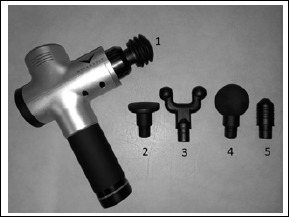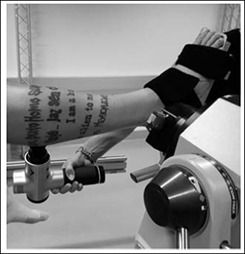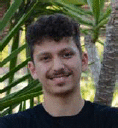Abstract
Handheld percussive massage treatment has gained popularity in recent years, for both therapeutic use and in sports practice. It is used with the goals of increasing flexibility and performance, but also to accelerate recovery. However, until now, there has been no scientific evidence, which proves such effects. Therefore, the purpose of this study was to investigate the effects of a 5-min percussion treatment of the calf muscles on range of motion (ROM) and maximum voluntary contraction (MVC) torque of the plantar flexor muscles. Sixteen healthy male volunteers (mean ± SD; 27.2 ± 4.2 years, 1.79 ± 0.05 m, 79.4 ± 9.1 kg) were tested on two separate days with either a 5-min massage treatment of the calf muscles with a Hypervolt device or the control condition (sitting only). Before and after the treatments, dorsiflexion ROM and MVC torque of the plantar flexor muscles were measured with a dynamometer. Maximum dorsiflexion ROM increased with a large magnitude following the massage treatment by 5.4° (+18.4%; p = 0.002, d= 1.36), while there was no change in the control group. Moreover, MVC torque did not change following both the massage treatment and the control treatment. Similar to a conventional massage by a therapist, ROM can be increased by a handheld percussive massage treatment without having an effect on muscle strength.
Key points.
This study was the first to examine the effect of a 5-min handheld percussive massage treatment of the calf muscles on the ROM and muscle performance (MVC) of the plantar flexor muscles.
Dorsiflexion ROM increased following the percussive massage treatment
Since we found no changes in MVC, we suggest including a percussive massage treatment in a warm-up regimen to optimize the flexibility level of an athlete, without losing muscle performance
Key words: Theragun, percussion, vibration massage, massage therapy, massage gun
Introduction
Handheld percussive massage treatment has gained popularity in the therapeutic and athletic communities in the last few years. Different manufacturers (e.g. Theragun, Hyperice) provide percussion devices for both self-massage and massage by a therapist. Such devices are able to vibrate in different frequencies up to 53 Hz. Depending on the tissue (i.e. soft tissue vs. bony tissue), several attachment heads can be fixed to the devices (see Figure 1), so that local points can receive a massage (Hypervolt, Hyperice, California, US). A recent review (Davis et al., 2020) showed that conventional massage can improve delayed onset muscle soreness (DOMS) and can acutely increase range of motion (ROM). However, no improvements could be observed in strength, jump, sprint, endurance, and fatigue parameters. Similar to a conventional massage, vibration therapy of the whole body (by standing on a plate; (Veqar and Imtiyaz, 2014)), and also vibration of specific muscles with, for example, a vibrating foam roller (Cheatham et al., 2019), can increase ROM. Compared to a conventional massage, vibration therapy can also enhance strength parameters (Lee et al., 2018; Veqar and Imtiyaz, 2014).
Figure 1.

The handheld massage device (Hypervolt) with the different attachment heads which can be used. For this study, the soft attachment head was used (1). Further attachments which are provided with most percussive massage treatment devices are hard plain (2), spinal (3), hard ball (4), and trigger point (5) heads.
Percussive massage treatment likely combines the elements of a conventional massage and vibration therapy. However, there is a lack of scientific evidence as to how and if percussive massage treatment affects ROM and muscle strength. To date, only one conference paper has investigated the effects of a handheld percussive massage treatment device (Kujala et al., 2019). However, the authors did not find changes in vertical jump height following a 5-min massage with a percussion device on several lower body muscle groups.
To the best of our knowledge, to date, no study has investigated the acute effects of a handheld percussive massage treatment on both flexibility and muscle performance. Since percussive massage treatment has increased in popularity with strength and conditioning coaches, and athletes, this is a huge gap in the literature.
Therefore, the purpose of this study was to investigate the effects of a 5-min percussive massage treatment of the calf muscles on dorsiflexion ROM as well as maximum voluntary contraction (MVC) torque of the plantar flexors. According to the literature on conventional massage and vibration therapy techniques, we hypothesized that the percussive massage treatment would increase dorsiflexion ROM while having no negative effect on MVC torque.
Methods
Experimental design
Participants visited the laboratory for two sessions, with a two-day break in between, at the same time of day. The percussive massage treatment and the control trial were performed in random order. Before and after both treatments (massage and control), dorsiflexion ROM and MVC torque of the plantar flexor muscles were determined.
Subjects
Sixteen healthy recreational male athletes (mean ± SD; 27.2 ± 4.2 years, 1.79 ± 0.05 m, 79.4 ± 9.1 kg) volunteers participated in this study. Subjects with a history of lower leg injuries, any type of neuromuscular disorder, and elite athletes were excluded from the study. Subjects were informed about the testing procedure, but were not informed about the study’s aim and hypotheses. The study was approved by the local research ethics board, and written informed consent was obtained from all volunteers before the onset of the experimental procedures.
Measures
Measurements were performed after a standardized warm-up (10-min warm-up on a stationary bike at 60 rev/min with 90 Watts) in the following order: 1. ROM; 2. MVC; 3. massage treatment for 5 min or control condition (just sitting for 6 min); 4. ROM; 5. MVC.
Range of Motion (ROM) measurement
ROM was determined with an isokinetic dynamometer (CON-TREX MJ, CMV AG, Duebendorf, Switzerland) with the standard setup for ankle joint movement individually adjusted. Subjects were seated with a hip joint angle of 110°, with the foot resting on the dynamometer foot plate and the knee fully extended. Two oblique straps on the upper body and one strap around the thigh were used to secure the participant to the dynamometer and exclude any evasive movement. The foot was fixed barefooted with a strap to the dynamometer footplate, and the estimated ankle joint center was carefully aligned with the axis of the dynamometer to avoid any heel displacement. Participants were first moved to the neutral ankle joint position in the dynamometer (90°) and were subsequently asked to regulate the motor of the dynamometer with a remote control to get into a dorsiflexion (stretching) position until the point of maximum discomfort was reached. The difference between the maximum dorsiflexion and the neutral position was defined as the dorsiflexion RoM.
Maximum Voluntary Contraction (MVC) torque measurement
MVC measurement was performed with the dynamometer at a neutral ankle position (90°). Participants were instructed to perform three isometric MVCs of the plantar flexors for 5 s, with rest periods of at least 1 min between the measurements to avoid any fatigue. The attempt with the highest MVC torque value was taken for further analysis.
Percussive massage treatment
During the percussive massage treatment, subjects were seated on the dynamometer, with the same setup as in the previous measurements (ROM and MVC), but the ankle joint was rotated to 20° plantar flexion to ensure that the calf muscles were relaxed (see Figure 2). The percussive massage treatment was applied by the same investigator using a Hypervolt device (Hyperice, California, US). This device provides percussions at 53 Hz, with the soft attachment head (see Figure 1) being used for the massage. The percussive massage treatment was applied to the right calf muscles for 5 min in total. The focus for the first 2.5 min of the massage treatment was the medial gastrocnemius muscle, while the focus in the second 2.5 min was on the lateral gastrocnemius muscle. The investigator started the massage treatment at the very medial side of the treated muscle and moved the massage device longitudinally in a straight line from distal to proximal and back to distal within 20 s. Back at the distal end of the muscle the investigator moved the percussive massage device laterally and again moved it longitudinally from distal to proximal and back to distal. Thus, for each muscle, the massage started from the medial side and finished at the lateral side. The investigator always tried to apply the same pressure to the skin. The control group participants were seated in the same position; however, no massage was applied.
Figure 2.

During the percussive massage treatment, the subject was seated on the dynamometer (similar to the ROM and MVC assessments) and the investigator applied the massage with the Hypervolt massage device.
Statistical analyses
SPSS (version 20.0, SPSS Inc., Chicago, Illinois) was used for all the statistical analyses. A Shapiro-Wilk test was used to verify the normal distribution of all the variables. Subsequently, if the data were normally distributed, we performed a two-way repeated ANOVA (factors: time [pre vs. post] and treatment modality [massage vs. control]). Otherwise, we performed a Friedman test to test the effect of the treatment (massage vs. control). If the ANOVA test with repeated measures or the Friedman test were significant, we performed a t-test or a Wilcoxon test (both Bonferroni-corrected), respectively. To confirm the homogeneity between groups, we performed a t-test between the two groups and their pre-variables (massage vs. control). The effect sizes d (for t-test) and r (for Wilcoxon) were interpreted following the suggestions by Cohen (1988). Thus, the effect size d defines 0.2, 0.5, and 0.8 as small, medium, and large effect, respectively. Moreover, the effect size r defines <0.3, 0.3-0.5, and >0.5 as small, medium, and large effect, respectively. The statistical power and power analysis were calculated with the open source software G*Power (Faul et al., 2009). An alpha level of p = 0.05 was defined for the statistical significance of all the tests.
Results
Range of Motion (ROM)
The ANOVA test for ROM revealed a significant interaction effect (p = 0.003; F = 12,1; df = 15; η² = 0.44) and time effect (p < 0.0001; F = 23,9; df = 15; η² = 0.62), but no group effect (p = 0.83; F = 0.05; df = 15; η² = 0.003). The pairwise comparison showed a significant increase in ROM in the massage treatment group (+5.4°; +18.4%; p = 0.002) with a large magnitude (d = 1.36), but no significant change in the control group (+1.6°; +5,3%; p = 0.18) with a medium magnitude (d = 0.51) (see Table 1). Statistical power for the pairwise comparisons was 0.91 for the massage treatment group and 0.74 for the control group. The pre-test comparison of both groups showed no significant difference (p = 0.81).
Table 1.
Results of the maximum dorsiflexion range of motion (ROM) and maximum voluntary contraction (MVC) measurements. Data are means ±SD.
| Percussive massage treatment | Control | |||
|---|---|---|---|---|
| PRE | POST | PRE | POST | |
| ROM (°) | 29.30 ± 6.53 | 34.70 ± 7.38 * | 30.9 ± 8.9 | 32.53 ± 9.73 |
| MVC (Nm) | 179.24 ± 20.45 | 179.76 ± 20.17 | 176.8 ± 21.8 | 178.53 ± 20.69 |
* = significant difference between pre- and post-session data.
Maximum Voluntary Contraction (MVC)
The Friedman test for MVC showed no significant difference (P = 0.35; χ2 = 3.3). The changes between pre and post treatment for the massage group and control group were +0.53 Nm (+0.003%; p = 0.99) and +1.69 Nm (+1.0%; p = 0.65), respectively (see Table 1). The effect sizes for the changes were small for the massage group (r = 0.17) and medium for the control group (r = 0.31). Statistical power for the pairwise comparisons was 0.99 for the massage treatment group and 0.82 for the control group. The pre-test comparison of both groups showed no significant difference (p = 0.67).
Discussion
The purpose of this study was to investigate the effects of a 5-min percussive massage treatment of the calf muscles on dorsiflexion ROM and plantar flexors MVC torque. In accordance with our hypothesis, we found an increase in ROM without a negative effect on MVC torque.
As with a conventional massage (Davis et al., 2020), and also vibration therapy [whole body: (Veqar and Imtiyaz, 2014); localized: (Cheatham et al., 2019; Germann et al., 2018)], the dorsiflexion ROM was significantly increased (+5.4°) following a single percussive massage treatment with the Hypervolt device. According to the review by Weerapong et al. (2005), a possible mechanism for the increase in ROM following a conventional massage is biomechanical changes (i.e. reduction in muscle compliance), but also physiological (i.e. increased blood flow), neurological (i.e. reduction in perception of pain), and psychological changes (i.e. increased relaxation). More specifically, Eriksson Crommert et al. (2015) showed a reduction in muscle stiffness of the gastrocnemius medialis with shear wave elastography immediately after a massage. Moreover, thixotropic effects, assumed in foam rolling (Behm and Wilke, 2019) or stretching (Behm, 2018, p.48), can be a further explanation for the increase in ROM following the percussive massage treatment. Similar to foam rolling, the percussive massage treatment induces pressure and friction on the treated muscle, skin, and fascia. This could have an impact on fluid viscosity and, hence, lead to less resistance to a movement (Behm, 2018, p.48; Behm and Wilke, 2019). With regard to vibration therapy, the increase in ROM can be mainly explained by a decrease in perception of pain (Cheatham et al., 2019; Veqar and Imtiyaz, 2014). Thus, it can be assumed that the changes in ROM following the percussive massage treatment can be explained by a decrease in muscle stiffness, as well as by changes in perception of pain. Interestingly, a static 5-min stretching exercise conducted in our laboratory (Konrad et al., 2019) with the same setup seems to have a similar effect on ROM gain (+4.9°) to the 5-min massage in the current study (+5.4°). The increase in ROM following the static stretching exercise in this study (Konrad et al., 2019) was explained by a decrease in muscle stiffness. Thus, again, it can be assumed that the ROM increase following the percussive massage treatment is likely due a decrease in muscle stiffness.
With regard to the muscle performance, the percussive massage treatment did not result in changes in MVC. This is in accordance with the findings of Kujala et al. (2019), who did not find any changes in vertical jump performance following a 5-min percussive massage treatment of the lower leg muscles. Although the duration of the massage was similar in the study by Kujala et al. (2019) and the current study, the subjects of Kujala et al. (2019) received a massage of the gluteal, quadriceps, calves, and hamstring muscles of both legs, while in the present study the focus of the massage was on the right calf muscles only. Nevertheless, although subjects of the present study received a more pronounced stimulus, the effect (i.e. no change in muscle performance) was the same. The findings of the present study on muscle performance are similar to the results of a conventional massage (Davis et al., 2020), but differ from the findings on vibration therapy (Cheatham et al., 2019; Germann et al., 2018), where an increase in strength has been found. A possible mechanism for these findings might be that vibration therapy can stimulate more muscle receptors in all three types, which leads to increased motor fiber recruitment (Fallon and Macefield, 2007; Germann et al., 2018). Although, more muscle receptors in all three types are stimulated following vibration therapy, the response from Ia and II afferent are stronger compared to Ib afferent fibers (Fallon and Macefield, 2007).
A possible explanation for the contradictory findings between the various whole-body and local vibration therapies and the current findings might be found in the different massage durations and frequencies, and the different muscles examined. Thus, future studies should consider these parameters. Moreover, while the present study focused on muscle performance, future studies should additionally investigate the effects of percussive massage treatment on DOMS, pain, and trigger points. Since the handheld percussive massage device used in this study has different attachment heads (see Figure 1), it would be interesting to investigate possible differences between them. In addition, we recommend performing appropriate experiments to determine possible mechanisms (i.e. mechanical or neurological) which might explain changes in muscle performance parameters and flexibility.
Conclusion
Handheld percussive massage treatment is a novel approach for therapists and athletes. This study was the first to examine the effect of a 5-min massage of the calf muscles on the ROM and muscle performance (MVC) of the plantar flexor muscles. We observed an increase in ROM, but no change in MVC torque output. Therefore, we suggest including a percussive massage treatment in a warm-up regimen to optimize the flexibility level of an athlete, without losing muscle performance.
Acknowledgements
This study was supported by a grant (Project P 32078-B) from the Austrian Science Fund FWF. The authors have no conflicts of interests to declare. The experiments comply with the current laws of the country in which they were performed.
Biographies

Andreas KONRAD
Employment
Institute of Human Movement Science, Sport and Health, University of Graz
Degree
PhD, MSc
Research interests
Biomechanics, muscle performance, training science, muscle-tendon-unit, soccer science
E-mail: andreas.konrad@uni-graz.at

Christoph GLASHÜTTNER
Employment
Institute of Human Movement Science, Sport and Health, University of Graz
Degree
BSc
Research interests
Training science, biomechanics
E-mail: christoph.glashuettner@edu.uni-graz.at

Marina Maren REINER
Employment
Institute of Human Movement Science, Sport and Health, University of Graz
Degree
MSc, BSc
Research interests
Training science, biomechanics, muscle-tendon-unit
E-mail: marina.reiner@uni-graz.at

Daniel BERNSTEINER
Employment
Institute of Human Movement Science, Sport and Health, University of Graz
Degree
BSc student
Research interests
Training science, biomechanics
E-mail: daniel.bernsteiner@edu.uni-graz.at

Markus TILP
Employment
Prof., Institute of Human Movement Science, Sport and Health, University of Graz
Degree
PhD
Research interests
Biomechanics, training science, muscle-tendon-unit, sports game analysis
E-mail: markus.tilp@uni-graz.at
References
- Behm D. G. (2018) The Science and Physiology of Flexibility and Stretching: Implications and Applications in Sport Performance and Health. London, UK: Routledge Publishers. [Google Scholar]
- Behm D. G., Wilke J. (2019) Do Self-Myofascial Release Devices Release Myofascia? Rolling Mechanisms: A Narrative Review. Sports Medicine. 49, 1173–1181. [DOI] [PubMed] [Google Scholar]
- Cheatham S. W., Stull K. R., Kolber M. J. (2019) Comparison of a vibration roller and a nonvibration roller intervention on knee range of motion and pressure pain threshold: A randomized controlled trial. Journal of Sport Rehabilitation 28(1), 39–45. [DOI] [PubMed] [Google Scholar]
- Cohen J. (1988) Statistical Power Analysis for the Behavioral Sciences Second Edition. Hillsdale: Erlbaum. [Google Scholar]
- Davis H. L., Alabed S., Chico T. J. A. (2020) Effect of sports massage on performance and recovery: a systematic review and meta-analysis. BMJ Open Sport & Exercise Medicine 6(1), e000614. [DOI] [PMC free article] [PubMed] [Google Scholar]
- Eriksson Crommert M., Lacourpaille L., Heales L. J., Tucker K., Hug F. (2015). Massage induces an immediate, albeit short-term, reduction in muscle stiffness. Scandinavian Journal of Medicine and Science in Sports 25(5), e490–e496. [DOI] [PubMed] [Google Scholar]
- Fallon J. B., Macefield V. G. (2007) Vibration sensitivity of human muscle spindles and golgi tendon organs. Muscle and Nerve 36(1), 21–29. [DOI] [PubMed] [Google Scholar]
- Faul F., Erdfelder E., Buchner A., Lang A.-G. (2009) Statistical power analyses using G*Power 3.1: tests for correlation and regression analyses. Behavior Research Methods 41(4), 1149–1160. [DOI] [PubMed] [Google Scholar]
- Germann D., El Bouse A., Shnier J., Abdelkader N., Kazemi M. (2018) Effects of local vibration therapy on various performance parameters: A narrative literature review. Journal of the Canadian Chiropractic Association 62(3), 170–181. [PMC free article] [PubMed] [Google Scholar]
- Konrad A., Reiner M. M., Thaller S., Tilp M. (2019) The time course of muscle-tendon properties and function responses of a five-minute static stretching exercise. European Journal of Sport Science 19, 1195-1202. [DOI] [PMC free article] [PubMed] [Google Scholar]
- Kujala R., Davis C., Young L. (2019) The effect of handheld percussion treatment on vertical jump height. International Journal of Exercise Science: Conference Proceedings 8(7). 75. [Google Scholar]
- Lee C. L., Chu I. H., Lyu B. J., Chang W. D., Chang N. J. (2018) Comparison of vibration rolling, nonvibration rolling, and static stretching as a warm-up exercise on flexibility, joint proprioception, muscle strength, and balance in young adults. Journal of Sports Sciences 36(22), 2575–2582. [DOI] [PubMed] [Google Scholar]
- Veqar Z., Imtiyaz S. (2014) Vibration Therapy in Management of Delayed Onset Muscle Soreness (DOMS). Journal Of Clinical and Diagnostic Research 8(6), LE01-LE4. [DOI] [PMC free article] [PubMed] [Google Scholar]
- Weerapong P., Hume P. A., Kolt G. S. (2005). The mechanisms of massage and effects on performance, muscle recovery and injury prevention. Sports Medicine 35, 235–256. [DOI] [PubMed] [Google Scholar]


